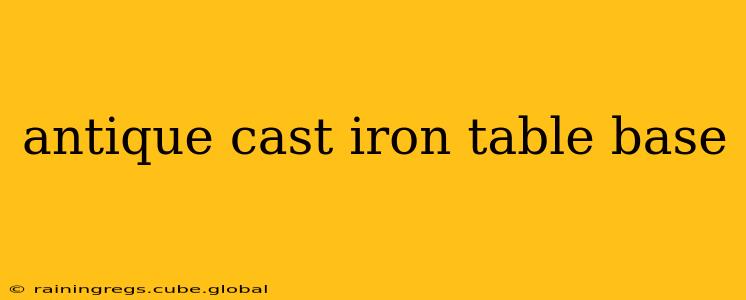Antique cast iron table bases represent a unique blend of artistry, history, and enduring strength. These stunning pieces, often found in homes, antique shops, and online marketplaces, can add a touch of vintage charm and substantial character to any interior. But choosing the right one requires understanding their history, identifying different styles, and appreciating their potential for restoration and repurposing. This guide delves into the world of antique cast iron table bases, offering insights for collectors, renovators, and anyone captivated by their timeless appeal.
What Makes Antique Cast Iron Table Bases So Special?
The allure of antique cast iron table bases stems from several factors. Firstly, their durability is undeniable. Cast iron, with its inherent strength and resilience, has allowed these bases to withstand the test of time. Many have survived decades, even centuries, bearing witness to countless gatherings and historical events. Secondly, the artistic merit is noteworthy. Many antique bases boast intricate designs, showcasing the skilled craftsmanship of bygone eras. From Victorian flourishes to Art Nouveau elegance, the decorative elements reflect the prevailing aesthetic styles of their time. Finally, their versatility is remarkable. These bases can be paired with a variety of tabletops, from simple wood slabs to custom-made glass or marble surfaces, allowing for personalized expression and design flexibility.
How to Identify Different Styles of Antique Cast Iron Table Bases
Antique cast iron table bases come in a dazzling array of styles, reflecting the diverse tastes and trends across different historical periods. Here are a few key styles to look out for:
-
Victorian Era (1837-1901): Characterized by ornate detailing, often featuring floral motifs, scrolls, and acanthus leaves. Expect heavy, substantial bases with a sense of grandeur.
-
Edwardian Era (1901-1910): A transition period, showcasing a slightly simpler aesthetic than the Victorian era, but still retaining elegant details. Expect more refined curves and less densely packed ornamentation.
-
Art Nouveau (1890-1910): This style emphasizes flowing lines, organic forms, and asymmetrical designs. Expect graceful curves, stylized floral patterns, and a sense of fluidity.
-
Art Deco (1920-1939): Defined by geometric shapes, bold lines, and a streamlined aesthetic. Expect clean lines, zigzags, and a more modern feel compared to earlier styles.
What Should I Look for When Buying an Antique Cast Iron Table Base?
Acquiring an antique cast iron table base is an investment. Here’s what to consider:
-
Condition: Examine the base for cracks, rust, pitting, or other damage. Minor imperfections are often acceptable, but significant damage can impact both its aesthetic appeal and structural integrity.
-
Style and Design: Consider your personal preferences and the overall style of your home decor. Choose a base that complements your existing furniture and enhances the ambiance of your space.
-
Size and Scale: Ensure the base is appropriately sized for the intended tabletop and the room where it will be placed. A disproportionately large or small base can look awkward.
-
Price: Antique cast iron table bases can range widely in price, depending on their condition, style, rarity, and provenance. Research comparable pieces to ensure you’re getting a fair deal.
How to Clean and Restore an Antique Cast Iron Table Base?
Cleaning and restoring an antique cast iron table base can significantly enhance its appearance and longevity. Gentle cleaning with a soft brush and mild soap is usually sufficient for routine maintenance. For more significant rust or damage, specialized cleaning products and techniques may be necessary. Consult with a professional restorer for guidance on more complex restoration projects.
Are There Different Sizes and Heights of Antique Cast Iron Table Bases?
Yes, antique cast iron table bases come in a wide variety of sizes and heights, depending on their intended use and the style of the era they represent. Smaller bases were often used for smaller tables, such as side tables or occasional tables. Larger, more substantial bases were typically used for dining tables or other larger furniture pieces. The height is also variable, with taller bases typically used for dining tables and shorter ones for coffee tables or side tables.
Where Can I Find Antique Cast Iron Table Bases?
Antique cast iron table bases can be found in various places, including:
-
Antique shops and malls: These are prime locations for finding a wide selection of antique furniture.
-
Online marketplaces: Websites such as eBay, Etsy, and others often have listings for antique cast iron table bases.
-
Estate sales and auctions: These offer opportunities to find unique and sometimes rare pieces.
-
Flea markets and antique shows: These events offer a chance to browse and discover hidden gems.
By understanding the nuances of antique cast iron table bases, collectors can appreciate their historical significance and aesthetic value. With careful selection, restoration, and placement, these timeless pieces can become cherished focal points in any home, adding a touch of vintage elegance and enduring charm.
